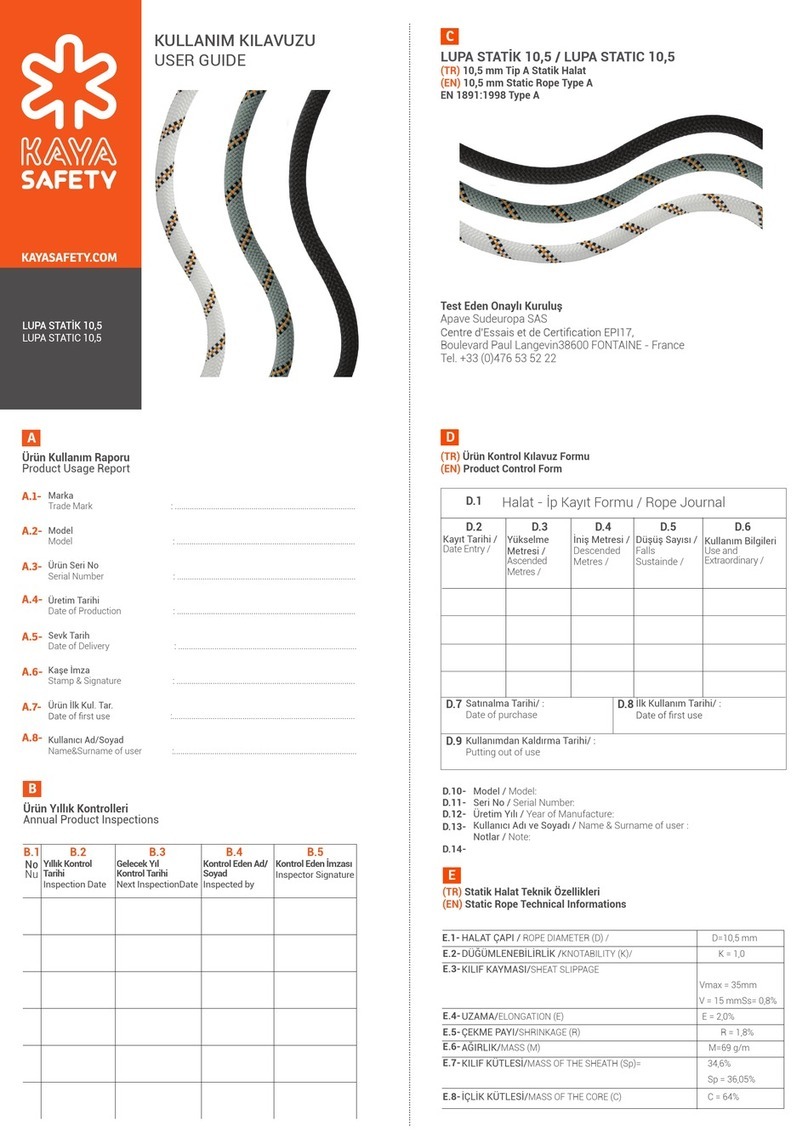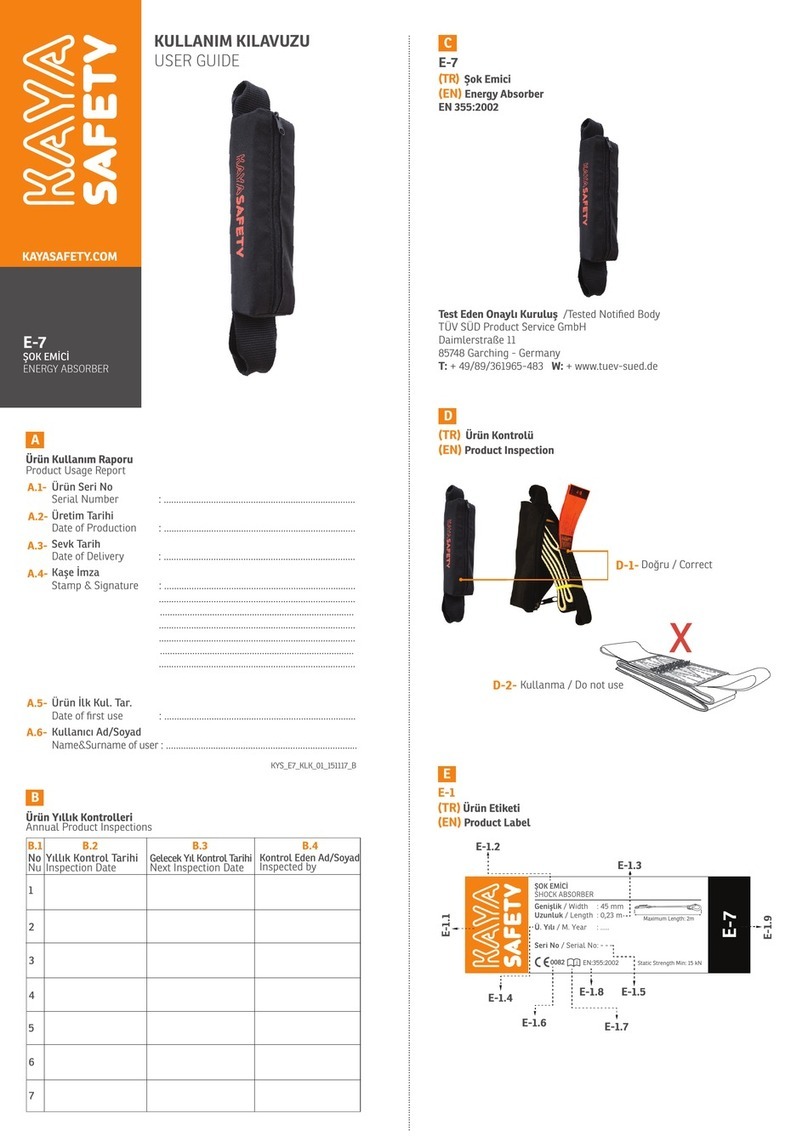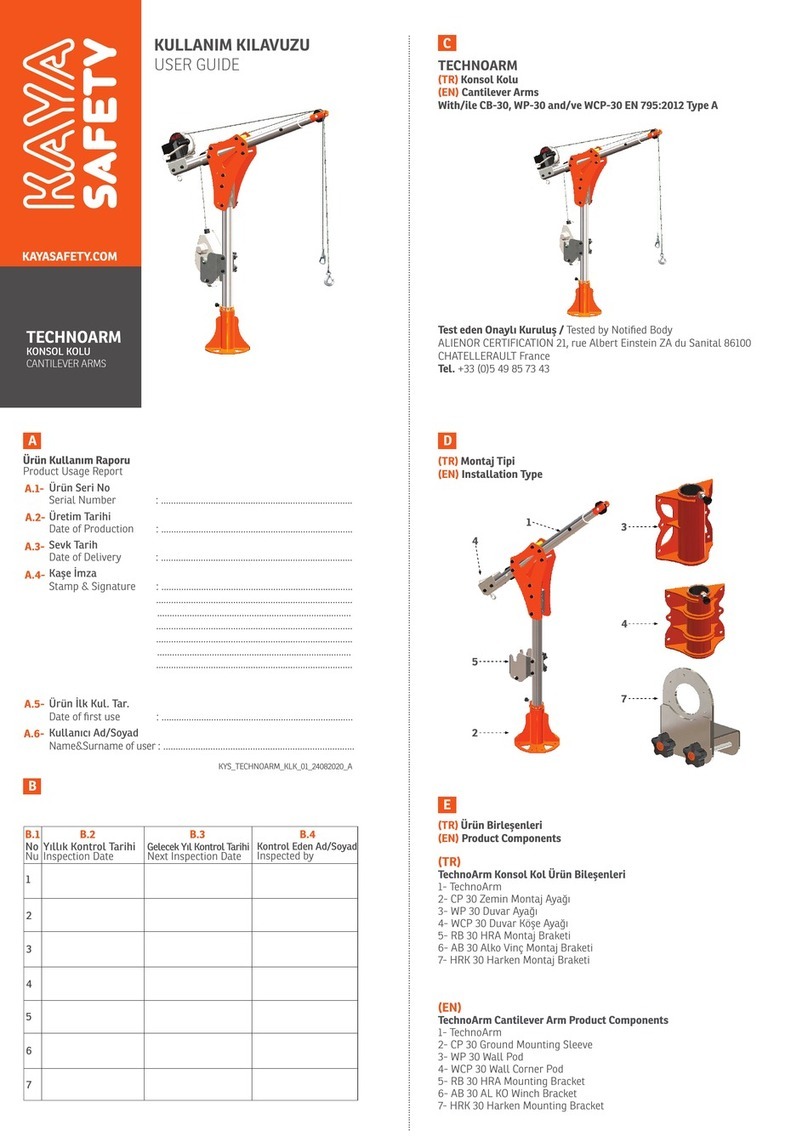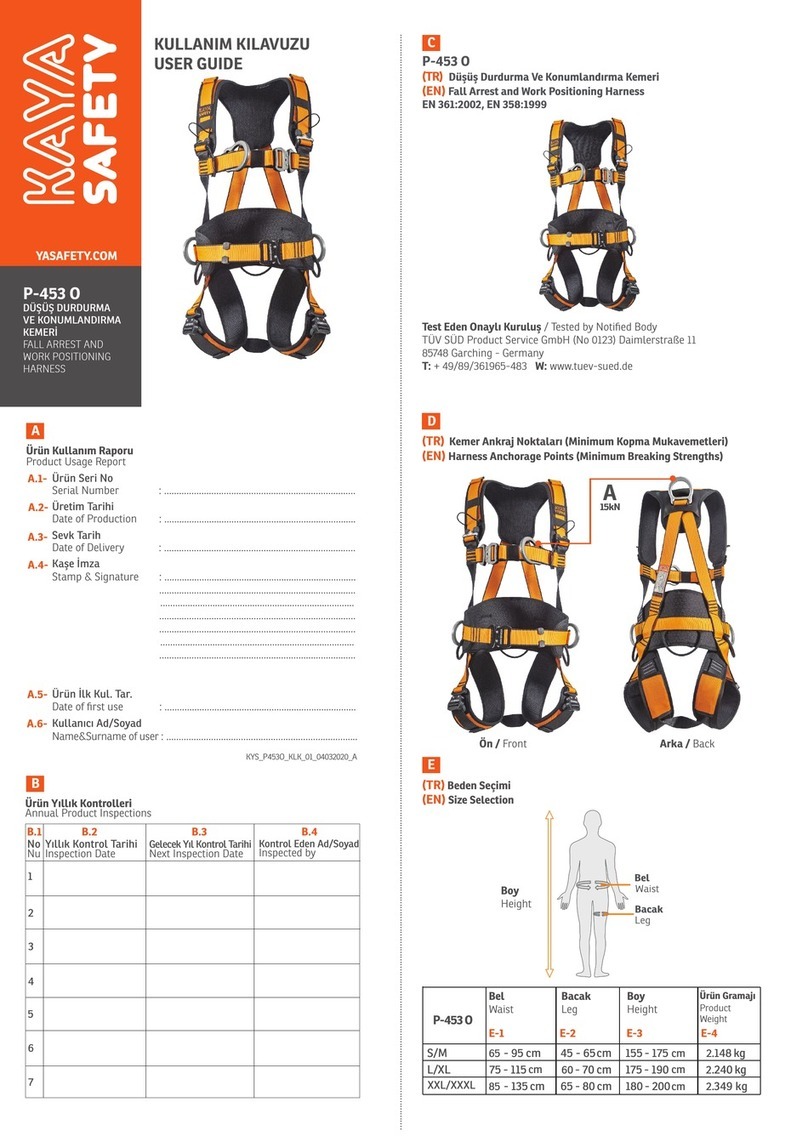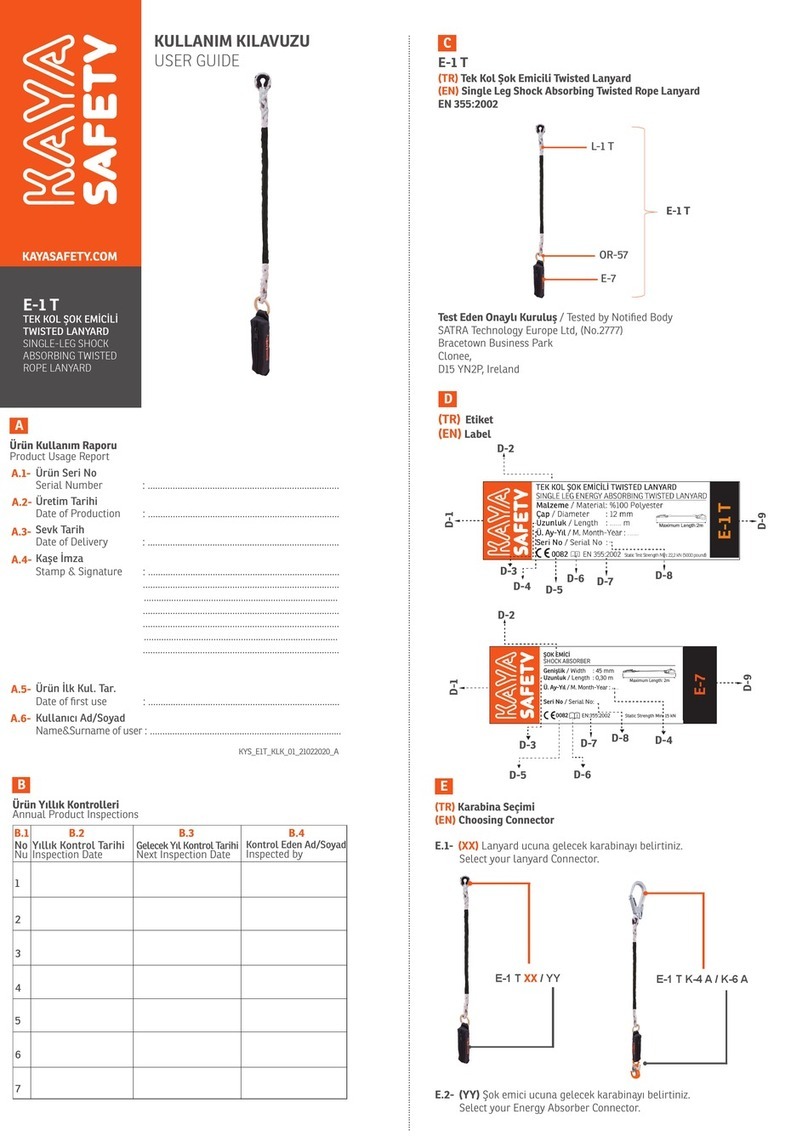
.........................................................................................................................................................................................................................................................................................................................................................................................................................................................
working at height, it must also be used together with CE certificated Lanyards
EN 354, shock absorbers EN 355, hooks EN 362 and fall arresters EN 360.
2. Raw Material
This safety harness is made of;
Webbing for harness and Yarns: Polyester
D ring and Buckle: Stainless Steel.
Webbing Holder and Back Plate : Polyprophilen
3. General Specification
* Personal Protective Equipment (PPE)
* This full body harness enables the user to work safely by making a
connection to a secure point with an appropriate tool. This safety harness
is manufactured in comply with standards of EN 361:2002 specified in PPE
Regulation 2016/425 (EU).
4.Product Use
4.1 EN 361:2002 Fall Arrest Harness
* Full Body Fall Arrest Harness
When full body fall arrest harness is used as fall arrester , all components of
.)metsystserralluF(363NEfostnemeriuqerehthtiwylpmocdluohsmetsyseht
Remainingequipmtents which are anchoring points of harness must comply with
EN 795, Lanyards must comply with EN 354, Shock absorbers must comply with
EN 355 , Carabiner must comply with EN 362.
* Dorsal D Ring; (Figure- 1)
Use only back D rings of safety harness with other equipments described in EN
363 (Shock absorber, lanyard, fall arrest systems). These points were marked
with “A” in order to be recognized easily.
The maximum rated load of the sit harness is 100 kg.
Warning:The adjustment and the tightness of the buckles and webbings
should be checked regularly during use.
4.2 Fall Clearance Distance = A+B+C+D
Fall Clearance (Calculation of fall clearance distance Figure- 2)
Clearance distance should be calcutlated in working area for a possible fall. In
case of fallfrom height, user should be able to adjust the clearence distance in
order not to hit any object or ground.
Fall Clearance
Fall clearance is the height at which a worker must attach to an anchorage to
avoid contact with a lower level. In order to calculate required fall clearance
distance the following measurements must be kept in mind.
A : Length of Fall Arrest System (Lanyard)
B : Length of the Shoch Absorber after a fall
C : Height of Suspended Worker
D : Safety Factor
5 Product Control and Validation
5.1 Before Each Use
Working at height equipment must be used as personalized. These products
must be controled on regular basis before and after each use and findings
must be recorded into product control form. Apply following controls on
an adequately lighted environment by lying the product down on a flat
surface;
• Webbings should be checked for cuts, abrasions, color change, broken
stitches and undue stretching.
• Buckles should be checked for signs of wear, cracks, deformation, corrosion
or other damages. They should function correctly and smoothly.
• D Rings and other metal parts should be checked for signs of wear,
cracks, deformation, corrosion or other damage.
• Connectors should be checked for sign of wear, cracks, deformation, corrosion,
dirt. The gate and the locking mechanisms should work properly. The gate
should open and close completely.
• Labels should be secure and legible.
During the controls if at least one of these deviation is found, usage of the
equipment should be suspended or retired and must be immediately sent
back to producer for detailed inspection. No repair is allowed by unauthorised
person. Only manufacturer directions should be applied.
5.2 During Each Use
When use product with a system , make sure that all pieces of equipment in
the system are correctly positioned and compatible with each other.
6. Supplementary Information Regarding Standard; EN 365
6.1 Rescue Plan
A worker who has been incapacitated by an injury or medical condition and
who is suspended by the full body harness must be rescued immediately.
So you must always have a rescue plan for such emergency situations. For
this adequately trained personnel and rescue equipment must be present.
6.2 Anchor Point
The anchor point of the system comprises this product should preferably
be located above the user or should at least at the waist level of the user.
An attachment point below this level will cause a serious injury or death.
The anchor point must conform to the requirements of the EN 795 standard
and the minimum strength of it must be12kN.
6.3 Various Situation
* A fall arrest harness is the only device allowable for supporting the body in
a fall arrest system.
* In a fall arrest system, it is essential to check the required clearance under
the user before each use, to avoid any collision with the ground or an obstacle
in case of a fall.
* Make sure that the anchor point is correctly positioned, in order to limit the
risk and the height of afall.
* When using multiple pieces of equipment together, a dangerous situation
can result if the safety
function of one piece of equipment is affected by the safety function of
another piece of equipment.
* Users must be medically fit for activities at height. Warning, inert suspension
in a harness can result in
serious injury or death.
7. Kaya General Information
7.1 Life Span
Although the potential lifespan is 10 years from the date of production, it is
very difficult to define the exact service life as it varies according to the fre-
quency and intense of use, environmental conditions, correct maintenance
and storage. Recommended life expectancy of this Fall Arrest Harness is 5
years from date of first use.
If the product has one of the deviations below it should be withdrawn from
service immediately and should be destroyed to prevent further usage.
• It has suffered a heavy shock load or has had a load dropped onto it.
• There are discoloration, stiffness, cuts and tears, glazed or fused areas on
the webbing.• There are cracks, deformation, corrosion or excessive wear
on the metal parts.
• It fails to pass inspection (before usage or detailed inspection).
• Labels (markings) are illegible or absent.
• It is extremely dirty and does not respond to normal washing.
• It has come into contact with chemicals and especially acids or is even
suspected.
• Its history is unknown.
• Its lifespan stated in the user’s manual has expired or even it has never
been used.
• There is a slightest doubt that the product is no more safe and reliable.
7.2 Storage
Product is sold with storage bag and user guide. Additionally model and
applied standards are provided with the product. During the storage keep
the product in it’s own bag. Storage area of the product should meet the
following requirements;
- Dry, away from direct sun light, room temperature.
- Do not store together with acids, solvents etc.
- Keep away from direct heat sources.
- If the product gets humid during the storage, dry the product in room
temperature before usage.
7.3 Maintenance
Personal protection equipment should be checked regularly to make sure
that the equipment will operate properly whenever it is used Harness can
be wiped with a wet sponge, for cleaning. A mild soap and warm water not
exceeding 30ºC can be used for difficult stains.
After cleaning, it should be thoroughly rinsed in clean cold water, hung out
in a dry, dark and cool place and kept away from the direct heat sources.
Harnesses should be hung out or placed loosely in a bag or another con-
tainer in order to protect it from harmful fumes, corrosive agent or light
(artificial or sunlight). Do not use acidic or solvent chemicals!
7.4 Changes and Repair
Changing a part, repair and addition to any component to product is strictly
forbidden without written authorization of KAYA. Any repair can be made only
by KAYA. Otherwise KAYA is not responsible for any possible consequences.
7.5 Transportation of Product
The product should be transported in a bag to protect it from damp,
chemicals and other objects.
7.6 Periodic Inspection of Product
Harness should be inspected by the user before each use and an additional
detailed inspection must be carried out by an authorized person in every
12 months.



